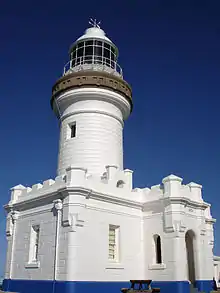Green Cape Lighthouse
The Green Cape Lighthouse is a heritage-listed lighthouse located at the tip of Green Cape, a headland forming the northern boundary of Disaster Bay, in southern New South Wales, Australia. It is the southernmost lighthouse in New South Wales and Australia's first lighthouse built in concrete. At 29 metres (95 ft) it is also the second tallest lighthouse in New South Wales.[1][2] It marks Green Cape on the northerly shore-hugging sailing course.
 Green Cape Lighthouse | |
 Location in New South Wales | |

| |
| Location | Green Cape New South Wales Australia |
|---|---|
| Coordinates | 37°15′41″S 150°02′58″E |
| Year first lit | 1883 |
| Deactivated | 1992 |
| Construction | concrete tower |
| Tower shape | square base octagonal tower with balcony and lantern |
| Markings / pattern | white tower, black balcony |
| Tower height | 29 metres (95 ft) |
| Focal height | 44 metres (144 ft) |
| Original lens | 1st order Fresnel lens |
| Light source | mains power |
| Intensity | 1,000,000 cd |
| Range | 40 kilometres (25 mi) |
| Characteristic | Fl (2) W 10s. |
| Admiralty number | K2570 |
| NGA number | 6588 |
| ARLHS number | AUS-085 |
| Managing agent | Australian Maritime Safety Authority |
| Heritage | Heritage Act - State Heritage Register |
The lighthouse was designed by James Barnet and built from 1881 to 1883 by Albert Wood Aspinall. It was added to the New South Wales State Heritage Register on 1 February 2013.[3]
History
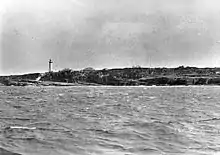
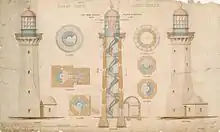
Green Cape is traditionally part of the Yuin nation and is the land of the Thaua people. The land occupied by the Thaua group stretches from Merimbula in the north, to Green Cape in the south, and west to the Dividing Range and has traditionally been divided between two groups – the Katungal (coastal) and the Baianbal/Paienbara (forest) people.[3]
The first contact between the European explorers and the Aboriginal people of the far southern region of NSW occurred in 1798 when Matthew Flinders visited Twofold Bay, south of Eden. On this exploratory journey, Flinders made reference to Green Point or, as he called it then, "the Cape". Permanent European settlement of the region did not, however, begin until the 1830s and 1840s when the pastoralist and whaling industries developed at Twofold Bay.[3]
"Twofold Bay afforded the potential for raising stock on unoccupied Crown Land in the vicinity of a commodious harbour"[4] and it quickly became a commercial and trading centre during the mid-nineteenth century. The Imlay brothers were the first settlers to permanently occupy the area from the late 1830s and established a pastoral and whaling company in the region.[3]
The developing industries around Twofold Bay soon revealed the potential of the region and began attracting competition for the Imlay brothers. The British entrepreneur Ben Boyd arrived and went about establishing his own commercial empire during the 1840s – the ambitious but short-lived "Boyd Town". By the time Boyd had entered the whaling industry, the once thriving business was reaching the end of its boom period – the Imlay brothers had fallen victim to the economic depression in the late 1840s and, by 1849, Boyd too had abandoned his pastoral lands following the collapse of his empire.[3]
Although whaling had not been a sustainable industry in the region, the Green Cape area was a notable point in the shipping trade along the NSW coastline. A prominent natural headland projecting out into Disaster Bay, Green Cape was a known obstacle for passing ships. Since shipping had accelerated following the gold rush of the 1850s, the entire NSW coastline, in fact, had been regarded as dangerous and increasingly treacherous. Despite the first lighthouse being constructed at South Head in 1818, it was some 40 years before the government systematically began installing lightstations along the coast.[3]
Initially, consideration was only given to the north coast of NSW but, by 1872, the entire coastline was under review. Captain Francis Hixson, President of the Marine Board of NSW, famously proclaimed "that he wanted the NSW coast "illuminated like a street with lamps" " (NPWS "Lighthouse Keeping (Part A)", p15). Hixson was ultimately successful in achieving his vision – by the early twentieth century, the "highway of lights" was complete with 25 coastal lighthouses and 12 in Sydney Harbour. The late nineteenth century had proven to be the most productive period for lighthouse construction in NSW.[3]
The need for a lighthouse was approved in 1873 at the conference of the Principal Officers of Marine Departments of the Australian Colonies on a motion from Hixson, following a series of wrecks on the southern shore. After rounding Cape Howe, northerly ships would hug the shore to avoid the East Australian Current. Green Cape was the first major projection they would encounter. Original tenders were for a stone lighthouse and rubble quarters. However, with the soft local sedimentary, no one tendered. In 1870 the specifications were changed to concrete and a budget of £17,000 AUD was set.
With an approved design by the colonial architect James Barnet in 1880, a tender of £12,936 was accepted from Albert Aspinall in December 1880 to build a mass concrete tower for the lighthouse, three associated residential structures and a number of service buildings. Aspinall also received an additional 357 pounds for essential works at Bittangabee Bay.[3][5]
Aspinall first had to find a way to move the materials from Eden to the site. The nearest safe anchorage was in Bittangabee Bay, north along the coast from Green Cape, where he built his storeroom and jetty. He then spent five months building a 7 kilometres (4.3 mi) wooden tramway from Bittangabee Bay to the cape. Materials were transported to the site on wooden trolleys pulled by horses. This first phase was completed in June 1881, and Aspinall commenced the construction.
The construction of a lightstation at Green Cape was considered essential and the project was ambitious from its beginnings. Concrete construction was a bold initiative for the period and Green Cape Lightstation was one of the earliest and most extensive concrete constructions ever attempted in Australia and the tallest in NSW at the time. Prior to 1880, some small houses were built using concrete but no public buildings, and certainly none as substantial as the Green Cape, had been constructed using the material.[3]
Work began in 1881 but Aspinall soon encountered significant difficulties that led to increasing delays and an extension of the budget to over 18,000 pounds. A 20-foot thick clay bed required extensive excavation and, with drifting sand continually covering the tramway and building foundations, the demanding circumstances of the build led to the eventual financial collapse of Aspinall's career. Ultimately, the Green Cape Lightstation was completed by his creditors and was fully operational, with a kerosene-powered light visible for 35 km, by 1883. The final cost for the lighthouse was 19,388 pounds, 8 shillings and 9 pence.[3]
The original apparatus, still mounted in the lantern, is a Chance Bros. 1st order revolving Fresnel lens dioptric. Its light characteristic was one flash every 50 seconds[6] and it was visible to 19 nautical miles (35 km; 22 mi).[7] The light source was a four-wick kerosene-burning lamp with an intensity of 100,000 cd.
The newly completed Green Cape Lightstation was in this functional state on 30 May 1886 – the night of the Ly-ee-Moon disaster. On a clear, calm night en route from Melbourne to Sydney, the paddle-steamer ran full-speed into rocks at the base of the lighthouse and quickly broke apart. Seventy-one lives were lost in the sinking – one of the greatest losses of human life in a single shipwreck in the state's history. Fifteen men (ten crew and five passengers) survived the shipwreck but only 24 bodies were ever recovered and buried in unmarked graves in a small cemetery a short distance from the lightstation. Flora MacKillop, the mother of Mary MacKillop, died in that accident.[8][3]
The wreck of the Ly-ee-Moon is considered to be one of NSW's worst maritime disasters but the far south coast of NSW has been responsible for a number of shipwrecks since the nineteenth century. Often caused by heavy seas and rough weather, Disaster Bay has become "a veritable graveyard" of ships.[9][3] 4
In 1910 the light source was replaced with a Douglas vaporised kerosene burner and a glass chimney around a silk mantle, made by Chance Bros.. In 1913 it was recommended to change the light characteristic to a white flash every 10 seconds. However, it took 16 years until this recommendation was accepted, in 1926. Previous to that, in 1923, the light source was upgraded to a Ford Schmidt burner which increased the intensity of the light to 327,000 cd.
Throughout the twentieth century, the Green Cape Lightstation underwent the same technical advancements as did all coastal lighthouses in Australia. With responsibility transferred to the Commonwealth in 1911, the lightstation was converted from kerosene to electricity in 1962. In 1962 the tower was electrified with diesel generators serving as the power source. The manual winding system was also replaced with an electric motor. The lightglove used provided a light intensity of 475,000 cd. In 1967 improved generators were installed together with a 1000 W Tungsten-halogen lamp with an intensity of 1,000,000 cd, visible over 20 nautical miles (37 km; 23 mi). The light characteristic was changed to two flashes every ten seconds. At some later point, the power source was changed to the mains electricity. The lighthouse was then gradually de-manned over the next 30 years.
In 1992[10] a solar powered lens on a modern lattice skeletal steel tower was constructed right next to the historic tower, and the light was officially turned off on 17 March 1992. The new light operates a 36 W lamp with an intensity of 37,500 cd. With this conversion, the lightstation was effectively de-manned and a caretaker installed at the site.[3] Since being replaced by a new and fully automatic lighthouse, the station has become a tourist destination and is being increasingly recognised for its heritage values. In 2009, Green Cape Lightstation was designated an Engineering Heritage National Landmark[11] – the first lighthouse to be accorded this level of recognition in Australia.[3]
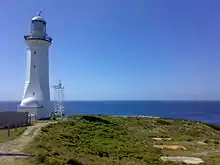 Green Cape Light. The current light is the skeletal tower to the right of the original tower. | |
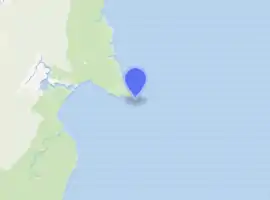
| |
| Location | Green Cape, New South Wales, Australia |
|---|---|
| Coordinates | 37°15′43″S 150°03′00″E |
| Year first constructed | 1992 |
| Construction | metal skeletal tower |
| Tower shape | square pyramidal tower |
| Markings / pattern | white tower |
| Tower height | 49 feet (15 m)[12] |
| Focal height | 118 feet (36 m)[13] |
| Intensity | 37,500 cd |
| Range | 17 nautical miles (31 km; 20 mi) |
| Characteristic | Fl (2) W 15s. |
| Admiralty number | K2570 |
| NGA number | 6588 |
| ARLHS number | AUS-260 |
| Managing agent | NSW National Parks (Ben Boyd National Park) |
| Heritage | Heritage Act - State Heritage Register |
Description
Green Cape is the location of the southernmost lightstation in NSW – some 400 km from Sydney and 27 km north of the Victorian border.[3]
The lightstation is a tightly knit complex of buildings that comprises the original lighthouse; the 1994 light tower; the Head Keepers Quarters; duplex quarters for the two Assistant Keepers; stables; telegraph station; ancillary buildings; communication tower; solar panels; and remnant foundations of various structures.[3]
At the eastern end of the main precinct, the Green Cape Lighthouse stands 29m tall, 23m above sea level. An octagonal concrete tower on a square base, the lighthouse is built of locally quarried rock aggregate and was finished with a Chance Bros lantern house. A small domed building, formerly used as an oil store, adjoins the lighthouse.[3]
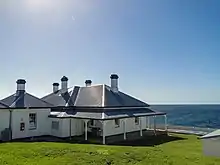
The complex of buildings that make up the lightstation include a number of simple painted rendered brick buildings typical of rural lightstations around Australia. The residences of the Head Keeper and the two Assistant Keepers (and families) were built in the Victorian Regency style and retain much of their original features and layout. The Head Keepers Quarters comprises four bedrooms with a parlour and living room, surrounded by a verandah on three sides. An adjoining annex houses storage rooms and an updated bathroom and kitchen. The Assistant Keepers Quarters are an identical duplex comprising two bedrooms, a living room, dining room, kitchen and bathroom (similarly updated). The duplexes are surrounded by verandahs on three sides also. The original arrangement of the quarters remains identifiable but a door has been fitted between the two living rooms to enable its use as a single residence.[3]
The original form of the other buildings in the lightstation complex (the stables, telegraph station etc.) are also evident despite later modifications that were made to support changes in use over time.[3]
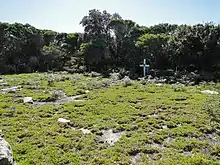
Immediately outside of the lightstation precinct, and 300m from the lighthouse, is the Ly-ee-Moon cemetery and, located off-shore, the shipwreck itself. The small cemetery is bound by a simple metal wire fence and contains 23 graves, each marked by a pair of white head and foot stones. The graves are positioned in two rows of ten and one smaller row of three but, with the passing of time, the graves are no longer identifiable. A bronze plaque was placed in the southern corner in 1986, on the centenary of the disaster.[3]
Located further afield, some 7 km north of the lightstation at Bittangabee Bay, there are remnants of the original port and jetty that was built prior to the construction of the lighthouse. A mass concrete store still stands (without windows, doors or a roof); concrete footings of the former jetty are evident on the rocky shore and there are existing remnants of the beginning of the tramway that transported materials and equipment to Green Cape for the construction of the lightstation.[3]
The ongoing use of the site as a lighthouse and as a tourist destination has ensured that the site is maintained to a very good standard. Permanent staff in residence at the site see to its day-to-day maintenance.[3]
Despite more recent alterations and modifications to kitchen and bathroom facilities to ensure the ongoing use of the site, the original detail and layout of the main buildings in the lightstation remains clearly evident today.[3]
Although the lightstation buildings have undergone some modifications to support the ongoing use of the site, the original detail and layout of the buildings remains evident today.[3] The layout of each of the residential buildings remains largely unaltered but the facilities have been updated.[3]
Recent modifications to the site include the conversion of the Head Keepers and Assistant Keepers Quarters to residences for the site caretaker and for holiday accommodation. Today, the site also has had solar panel boards installed and new fencing, car park and walking trails created.[3]
In 2012, the National Parks and Wildlife Service undertook necessary maintenance works (including rust removal, reglazing the light tower dome, treating rising damp in the residences, roof works, new paint, timber replacement and an electricity upgrade).[3]
As a complex, the integrity of the lightstation and its ability to demonstrate its history remains strong. This ability is reflected in its contemporary use as a tourist destination.[3]
Site operation
The current light is operated by the Australian Maritime Safety Authority. The site is managed by the Department of Environment, Climate Change and Water as part of the Ben Boyd National Park.
Visiting
The grounds are open to the public, and the tower is open to guided tours on some days of the week. Reservations for the guided tours are recommended. Accommodation is available in the two assistant keepers' cottages which sleep up to six people each.
Heritage listing
The Green Cape Maritime Precinct is of state heritage significance as a notable lightstation in the "highway of lights" that were erected along the NSW coastline during the late nineteenth century. Recommended by Captain Francis Hixson (President of the Marine Board of NSW) and designed by the colonial architect, James Barnet, Green Cape Lightstation was an ambitious and unique development for its period. Although the 1880s was the most productive period for the construction of lighthouses in NSW, Green Cape was one of the earliest and most extensive concrete constructions ever attempted in Australia.[3]
The construction of the lightstation was possible because of the development of Bittangabee Bay as a trans-shipment point to receive materials, equipment and labour for the construction. These materials were then taken along a horse-drawn tramway, seven kilometres through the forest to the site of the lightstation.[3]
The lightstation was also the site of the wrecking of the Ly-ee-Moon on the night of 30 May 1886. Considered to be one of NSW's worst maritime disasters, the loss of 71 lives that night was one of the greatest shipwreck tragedies in the state's history. Fifteen people survived the wreck and 24 bodies were recovered and buried in unmarked graves in a small cemetery a short distance from the lightstation.[3]
Green Cape Maritime Precinct was listed on the New South Wales State Heritage Register on 1 February 2013 having satisfied the following criteria.[3]
The place is important in demonstrating the course, or pattern, of cultural or natural history in New South Wales.
The Green Cape Maritime Precinct is of state heritage significance as a notable lightstation in the "highway of lights" that were erected along the NSW coastline during the late nineteenth century. Green Cape is a prominent headland projecting out into Disaster Bay and the lightstation was a significant development in protecting the shipping trade along the far south coast. At the time of its construction, the lighthouse was one of the earliest and most extensive concrete constructions ever attempted in Australia and the tallest in NSW.[3]
The construction of the lightstation was possible because of the development of Bittangabee Bay as a trans-shipment point to receive materials, equipment and labour for the construction. These materials were then taken along a horse-drawn tramway, seven kilometres through the forest to the site of the lightstation.[3]
The lightstation was also the site of the wrecking of the Ly-ee-Moon on the night of 30 May 1886. Considered to be one of NSW's worst maritime disasters, the loss of 71 lives that night was one of the greatest shipwreck tragedies in the state's history.[3]
The place has a strong or special association with a person, or group of persons, of importance of cultural or natural history of New South Wales's history.
The Green Cape Maritime Precinct is of state heritage significance for its association with a number of significant people and events.[3]
At the 1863 conference of the Principal Officers of Marine Departments of the Australian Colonies, Captain Francis Hixson (President of the Marine Board of NSW and the Superintendent of Pilots, Lighthouses & Harbours) proclaimed that he wanted the NSW coastline "illuminated like a street with lamps" (NPWS "Lighthouse Keeping (Part A)", p15). At the southernmost tip of the state, Hixson recommended the placement and construction of the Green Cape Lightstation – considered to be an important element in the NSW "highway of lights".[3]
The ambitious design of the lightstation is attributed to the colonial architect, James Barnet, who was responsible for more than a dozen lighthouses constructed in NSW in the late nineteenth century.[3]
The Green Cape Lightstation also has an association with the Ly-ee-Moon shipwreck. The loss of 71 lives on the night of 30 May 1886, is considered to be one of NSW's worst maritime disasters. Only 15 survived the tragedy and 24 bodies were recovered for burial in unmarked graves in a small cemetery a short distance from the lightstation.[3]
The place is important in demonstrating aesthetic characteristics and/or a high degree of creative or technical achievement in New South Wales.
At the southernmost point in NSW, Green Cape Lightstation is a dominant feature in an isolated but picturesque landscape – bounded by both state forest and the Tasman Sea.[3]
One of NSW's "highway of lights", the Green Cape Lightstation is a compact group of simple nineteenth-century buildings that are visually unified by alignment, scale and the use of common materials.[3]
The place has strong or special association with a particular community or cultural group in New South Wales for social, cultural or spiritual reasons.
Despite its isolated location, the Green Cape Maritime Precinct has layers of social significance.[3]
For over 100 years, the lightstation was permanently manned by a Principal Keeper, two Assistant Keepers and up to three families at any one time. Maintaining the light was of paramount importance to their experience of Green Cape. Additionally, their lives were inextricably linked to the landscape and ultimately shaped by the natural elements – the water, the cliffs and the native flora and fauna.[3]
There is also social significance evident in the Ly-ee-Moon shipwreck and the small cemetery located a short distance from the lightstation. Considered to be one of NSW's worst maritime disasters, 71 people perished on the wreck of the Ly-ee-Moon but only 24 bodies were ever recovered for burial. Although the gravesites are no longer identifiable, a memorial has been erected at the cemetery and, each year, the anniversary of the wreck is commemorated.[3]
While there are limited remains of the Ly-ee-Moon shipwreck extant, the site has social significance for the impact the event of its wrecking had on the population of NSW at the time.[3]
The place has potential to yield information that will contribute to an understanding of the cultural or natural history of New South Wales.
Within the Green Cape Maritime Precinct, there are opportunities to uncover further heritage values.[3]
The tramway that once ran 7 km through the forest, transporting goods from Bittangabee Bay to the Green Cape Lightstation, has now been, in the most part, lost from living memory. Further land analysis and archaeological surveys may reveal the location of this track.[3]
More recently, several investigations have revealed new information about the Green Cape site. Further archaeological surveys of the Ly-ee-Moon cemetery have been undertaken as well as oral histories of those lightkeepers and families that manned the Green Cape light for over 100 years.[3]
It is also highly likely that there is evidence of Aboriginal occupation of the Green Cape area. Previous investigations have revealed one shell midden and artefact scatter on the Green Cape headland and a number of other archaeological sites within the area. There is further scope to elaborate on these investigations to reveal new information.[3]
The place possesses uncommon, rare or endangered aspects of the cultural or natural history of New South Wales.
The Green Cape Lightstation is of state heritage significance for its rare and distinctive design. Although the complex of buildings is typical of a late nineteenth-century rural lightstation, the colonial architect James Barnet designed Green Cape with a square base merging into a tapered octagonal tower form – a design quite unlike the common circular towers that were being built at the time.[3]
Barnet's design was also rare in being one of the earliest mass concrete lighthouses in Australia and, standing at 29 metres, was the tallest tower in NSW at the time. Concrete construction was a bold initiative for the period and, although some small houses were built of the material prior to 1880, no public buildings (and certainly none as substantial as the Green Cape Lightstation) had been constructed using concrete. The use of Bittangabee Bay as a trans-shipment point for building materials indicate the extremely difficult logistics involved in the construction of a mass concrete structure in an isolated location during this period.[3]
The significant association between the lightstation and the Ly-ee-Moon shipwreck is also particularly unique. The wreck of the Ly-ee-Moon is considered to be one of NSW's worst maritime disasters and the existence of a substantial burial ground for the victims of this one shipwreck is rare in NSW.[3]
The place is important in demonstrating the principal characteristics of a class of cultural or natural places/environments in New South Wales.
The Green Cape Lightstation is representative of NSW's "highway of lights" – a system of navigational aids installed along the coastline in the late nineteenth century. Important to the safe passage of shipping in NSW, the system of lightstations has a collective significance that reflects the logistical management for installing coastal infrastructure and the technical evolution of the stations.[3]
There is also an architectural coherency between lightstations across NSW. As a representative example, the simple design and compact nature of the building group at Green Cape reflects the typical layout of regional lightstation complexes around Australia.[3]
Notes
- According to "Lighthouses of Australia". "DECCW – Ben Boyd National Park – Accommodation" says it is the tallest.
- According to the British Admiralty List of Lights and Foghorns, Vol. K, there is no lighthouse in NSW taller than Greencape. There is a tower in Newcastle at Throsby 32 meters high but it is a light on top of a grey metal pole which can't really be regarded as a lighthouse.
- "Green Cape Maritime Precinct". New South Wales State Heritage Register. Office of Environment and Heritage. H01897. Retrieved 2 June 2018.
- NPWS, "Ben Boyd National Park Bicentennial Project", p75
- "Item details". recordsearch.naa.gov.au. Retrieved 31 August 2010.
- According to Steve Merson. 60 seconds according to "SeaSide Lights"
- According to "SeaSide Lights" and Steve Merson. 34 km according to "Lighthouses of America".
- "Flora Mackillop".
- Francis Scott, p2
- According to all sources except "SeaSide Lights" which says 1998.
- "Green Cape Lightstation, Highway of Light, 1883–1992". Engineers Australia. Retrieved 29 April 2020.
- According to Directory of Lighthouses. "SeaSide Lights" list the height of the old light, 95 feet (29 m), with the focal height of the new one, 118 feet (36 m).
- According to List of Lights. "39 m (118 ft)" according to Directory of Lighthouses, which is a unit conversion error.
References
- List of Lights, Pub. 111: The West Coasts of North and South America (Excluding Continental U.S.A. and Hawaii), Australia, Tasmania, New Zealand, and the Islands of the North and South Pacific Oceans (PDF). List of Lights. United States National Geospatial-Intelligence Agency. 2009. p. 134.
- Rowlett, Russ. "Lighthouses of Australia: New South Wales". The Lighthouse Directory. University of North Carolina at Chapel Hill.
- "The Green Cape Lighthouse". Lighthouses of New South Wales. Lighthouses of Australia Inc.
- Searle, Garry. "Green Cape". Lighthouses of New South Wales. SeaSide Lights.
- Steve Merson (July–August 2004). "Light the coast like a street with lamps". Lighthouses of Australia Inc Bulletin (4). Retrieved 23 October 2017.
- "DECCW – Ben Boyd National Park – Accommodation". environment.nsw.gov.au. Retrieved 31 August 2010.
Bibliography
- Anne Bickford, Sandy Blair & Peter Freeman (1988). Ben Boyd National Park Bicentennial Project: Davidson Whaling Station, Boyd’s Tower, Bittangabee Ruins.
- Australian Construction Services (1993). Conservation Management Plan – Green Cape Lighthouse (superseded).
- Australian Maritime Safety Authority, Department of Transport (1977). Green Cape Lightstation.
- Cosmos Archaeology Pty Ltd (2011). Ly-ee-Moon Shipwreck Cemetery: Ground penetrating radar survey.
- Boleyn, Douglas (2009). Nomination of Green Cape Lightstation for recognition as a National Heritage Landmark.
- Douglas Boleyn, Sydney Division Engineering Heritage Committee, Engineers Australia (2011). SHR Nomination of 'Green Cape Lightstation and associated infrastructure at Bittangabee Bay'.CS1 maint: multiple names: authors list (link)
- Barrow, Graeme (2010). Who Lied? The Ly-ee-Moon Disaster and a Question of Truth.
- Graham Brooks & Associates Pty Ltd (1999). NPWS Draft Conservation Management and Cultural Tourism Plan – Green Cape Lighthouse.
- Heritage Division (2013). "Green Cape Maritime Precinct".
- John Francis Scott. The Whimsicality of Fate or the Long Arm of Coincidence.
- Kijas Histories (2011). Lighthouse Keeping – A Partnership: A Report on the NPWS Lighthouses of NSW Oral History Project (Part A).
- Riddel Architecture (2010). Green Cape Light Station: Conservation Management Plan.
- Mead, Tom (1993). The Fatal Lights: Two strange tragedies of the sea.
Attribution
![]() This Wikipedia article contains material from Green Cape Maritime Precinct, entry number 01897 in the New South Wales State Heritage Register published by the State of New South Wales and Office of Environment and Heritage 2018 under CC-BY 4.0 licence, accessed on 2 June 2018.
This Wikipedia article contains material from Green Cape Maritime Precinct, entry number 01897 in the New South Wales State Heritage Register published by the State of New South Wales and Office of Environment and Heritage 2018 under CC-BY 4.0 licence, accessed on 2 June 2018.
External links
| Wikimedia Commons has media related to Green Cape Lighthouse. |
- Australia’s iconic lighthouses, Australian Geographic, 26 July 2010
